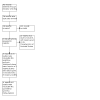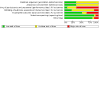Intermittent catheter techniques, strategies and designs for managing long-term bladder conditions
- PMID: 34699062
- PMCID: PMC8547544
- DOI: 10.1002/14651858.CD006008.pub5
Intermittent catheter techniques, strategies and designs for managing long-term bladder conditions
Abstract
Background: Intermittent catheterisation (IC) is a commonly recommended procedure for people with incomplete bladder emptying. Frequent complications are urinary tract infection (UTI), urethral trauma and discomfort during catheter use. Despite the many designs of intermittent catheter, including different lengths, materials and coatings, it is unclear which catheter techniques, strategies or designs affect the incidence of UTI and other complications, measures of satisfaction/quality of life and cost-effectiveness. This is an update of a Cochrane Review first published in 2007. OBJECTIVES: To assess the clinical and cost-effectiveness of different catheterisation techniques, strategies and catheter designs, and their impact, on UTI and other complications, and measures of satisfaction/quality of life among adults and children whose long-term bladder condition is managed by intermittent catheterisation.
Search methods: We searched the Cochrane Incontinence Specialised Register, which contains trials identified from the Cochrane Central Register of Controlled Trials (CENTRAL), MEDLINE, MEDLINE In-Process, MEDLINE Epub Ahead of Print, CINAHL, ClinicalTrials.gov, WHO ICTRP and handsearching of journals and conference proceedings (searched 12 April 2021), the reference lists of relevant articles and conference proceedings, and we attempted to contact other investigators for unpublished data or for clarification.
Selection criteria: Randomised controlled trials (RCTs) or randomised cross-over trials comparing at least two different catheterisation techniques, strategies or catheter designs.
Data collection and analysis: As per standard Cochrane methodological procedures, two review authors independently extracted data, assessed risk of bias and assessed the certainty of evidence using GRADE. Outcomes included the number of people with symptomatic urinary tract infections, complications such as urethral trauma/bleeding, comfort and ease of use of catheters, participant satisfaction and preference, quality of life measures and economic outcomes.
Main results: We included 23 trials (1339 randomised participants), including twelve RCTs and eleven cross-over trials. Most were small (fewer than 60 participants completed), although three trials had more than 100 participants. Length of follow-up ranged from one month to 12 months and there was considerable variation in definitions of UTI. Most of the data from cross-over trials were not presented in a useable form for this review. Risk of bias was unclear in many domains due to insufficient information in the trial reports and several trials were judged to have a high risk of performance bias due to lack of blinding and a high risk of attrition bias. The certainty of evidence was downgraded for risk of bias, and imprecision due to low numbers of participants. Aseptic versus clean technique We are uncertain if there is any difference between aseptic and clean techniques in the risk of symptomatic UTI because the evidence is low-certainty and the 95% confidence interval (CI) is consistent with possible benefit and possible harm (RR 1.20 95% CI 0.54 to 2.66; one study; 36 participants). We identified no data relating to the risk of adverse events comparing aseptic and clean techniques or participant satisfaction or preference. Single-use (sterile) catheter versus multiple-use (clean) We are uncertain if there is any difference between single-use and multiple-use catheters in terms of the risk of symptomatic UTI because the certainty of evidence is low and the 95% CI is consistent with possible benefit and possible harm (RR 0.98, 95% CI 0.55, 1.74; two studies; 97 participants). One study comparing single-use catheters to multiple-use catheters reported zero adverse events in either group; no other adverse event data were reported for this comparison. We identified no data for participant satisfaction or preference. Hydrophilic-coated catheters versus uncoated catheters We are uncertain if there is any difference between hydrophilic and uncoated catheters in terms of the number of people with symptomatic UTI because the certainty of evidence is low and the 95% CI is consistent with possible benefit and possible harm (RR 0.89, 95% CI 0.69 to 1.14; two studies; 98 participants). Uncoated catheters probably slightly reduce the risk of urethral trauma and bleeding compared to hydrophilic-coated catheters (RR 1.37, 95% CI 1.01 to 1.87; moderate-certainty evidence). The evidence is uncertain if hydrophilic-coated catheters compared with uncoated catheters has any effect on participant satisfaction measured on a 0-10 scale (MD 0.7 higher, 95% CI 0.19 to 1.21; very low-certainty evidence; one study; 114 participants). Due to the paucity of data, we could not assess the certainty of evidence relating to participant preference (one cross-over trial of 29 participants reported greater preference for a hydrophilic-coated catheter (19/29) compared to an uncoated catheter (10/29)). AUTHORS' CONCLUSIONS: Despite a total of 23 trials, the paucity of useable data and uncertainty of the evidence means that it remains unclear whether the incidence of UTI or other complications is affected by use of aseptic or clean technique, single (sterile) or multiple-use (clean) catheters, coated or uncoated catheters or different catheter lengths. The current research evidence is uncertain and design and reporting issues are significant. More well-designed trials are needed. Such trials should include analysis of cost-effectiveness because there are likely to be substantial differences associated with the use of different catheterisation techniques and strategies, and catheter designs.
Trial registration: ClinicalTrials.gov NCT00990093 NCT01523743 NCT01284361 NCT01048541 NCT01404481.
Copyright © 2021 The Cochrane Collaboration. Published by John Wiley & Sons, Ltd.
Conflict of interest statement
JP: none known CM: none known FS: none known MF: has received funding from the UK National Institute of Health Research for a trial on intermittent catheters (MULTICATH Trial registration ISRCTN42028483).
Figures








Update of
-
WITHDRAWN: Intermittent catheterisation for long-term bladder management.Cochrane Database Syst Rev. 2017 Aug 8;8(8):CD006008. doi: 10.1002/14651858.CD006008.pub4. Cochrane Database Syst Rev. 2017. Update in: Cochrane Database Syst Rev. 2021 Oct 26;10:CD006008. doi: 10.1002/14651858.CD006008.pub5. PMID: 28796279 Free PMC article. Updated.
References
References to studies included in this review
Biering‐Sorensen 2007 {published data only}
-
- Biering-Sorensen F, Hansen HV, Nielsen PN, Looms D. Residual urine after intermittent catheterization in females using two different catheters. Scandinavian Journal of Urology and Nephrology 2007;41(4):341-5. [sr-incont26273] - PubMed
Cardenas 2009 {published data only}
-
- Cardenas DD, Hoffman JM. Hydrophilic catheters versus noncoated catheters for reducing the incidence of urinary tract infections: a randomized controlled trial. Archives of Physical Medicine and Rehabilitation 2009;90(10):1668-71. [sr-incont34271] - PubMed
Cardenas 2011 {published data only}
-
- Cardenas DD, Moore KN, Dannels-McClure A, Scelza WM, Graves DE, Brooks M, et al. Intermittent catheterization with a hydrophilic-coated catheter delays urinary tract infections in acute spinal injury: a prospective randomized, multicenter trial. PM & R: Journal of Injury, Function, and Rehabilitation 2011;3(5):408-17. [sr-incont42588] - PubMed
Chartier‐Kastler 2011 {published data only}
-
- Chartier-Kastler E, Lauge I, Ruffion A, Goossens D, Charvier K, Biering-Sorensen F. Safety of a new compact catheter for men with neurogenic bladder dysfunction: a randomised, crossover and open-labelled study. Spinal Cord 2011;49(7):844-50. [NCT00990093] [sr-incont42729] - PubMed
-
- NCT00990093. A randomised, cross-over, open-labelled test catheter acceptance study [Randomised, cross-over, open-labelled study evaluating the acceptance of test catheters compared to SpeediCath catheters]. clinicaltrials.gov/show/NCT00990093 (first received 6 October 2009). [NCT00990093] [sr-incont96573]
Chartier‐Kastler 2013 {published data only}
-
- Chartier-Kastler E, Amarenco G, Lindbo L, Soljanik I, Andersen HL, Bagi P, et al. A prospective, randomized, crossover, multicenter study comparing quality of life using compact versus standard catheters for intermittent self-catheterization. Journal of Urology 2013;190(3):942-7. [NCT01523743] [sr-incont49366] - PubMed
-
- NCT01523743. Quality of life intermittent catheter study [Quality of life intermittent catheter study - a prospective, randomized, cross-over, multicenter study comparing quality of life using compact versus standard urinary intermittent catheters]. clinicaltrials.gov/show/NCT01523743 (first received 1 February 2012). [NCT01523743] [sr-incont50303]
Costa 2013 {published data only}
-
- Costa J, Menier M, Doran T, Köhler T. Catheter length preference in wheelchair-using men who perform routine clean intermittent catheterization. Spinal Cord 2013;51(10):772-5. [NCT01284361] [sr-incont49367] - PubMed
-
- Costa J, Menier M. Catheter length preference in wheelchair bound male patients who perform clean intermittent catheterisation (Abstract number 38). Neurourology and Urodynamics 2012;31(6):773-4. [NCT01284361] [sr-incont46729]
-
- NCT01284361. Comparison of two intermittent urinary catheters [User preference study to compare a 40cm intermittent catheter to a 30cm intermittent catheter]. clinicaltrials.gov/show/NCT01284361 (first received 27 January 2011). [NCT01284361] [sr-incont60733]
DeFoor 2017 {published data only}
-
- DeFoor W, Reddy P, Reed M, VanderBrink B, Jacksn E, Zhang B, et al. Results of a prospective randomized control trial comparing hydrophilic to uncoated catheters in children with neurogenic bladder. Journal of Pediatric Urology 2017;13(4):373.e1-5. [DOI: 10.1016/j.jpurol.2017.06.003] [sr-incont76903] - DOI - PubMed
De Ridder 2005 {published and unpublished data}
-
- De Ridder DJ, Everaert K, Fernandez LG, Valero JV, Duran AB, Abrisqueta ML, et al. Intermittent catheterisation with hydrophilic-coated catheters (SpeediCath) reduces the risk of clinical urinary tract infection in spinal cord injured patients: a prospective randomised parallel comparative trial. European Urology 2005;48(6):991-5. [sr-incont21227] - PubMed
Domurath 2011 {published data only}
-
- Domurath B, Kutzenberger J, Kurze I, Knoth HS. Clinical evaluation of a newly developed catheter (SpeediCath Compact Male) in men with spinal cord injury: residual urine and user evaluation. Spinal Cord 2011;49(7):817–21. [NCT01048541] [sr-incont42728] - PubMed
-
- NCT01048541. Bladder scan of residual urine with new catheter [A non-inferiority bladder scan study to investigate residual urine after use of intermittent catheters in male subjects]. clinicaltrials.gov/show/NCT01048541 (first received 13 January 2010). [NCT01048541] [sr-incont49337]
Duffy 1995 {published data only}
-
- Duffy LM, Cleary J, Ahern S, Kuskowski MA, West M, Wheeler L, et al. Clean intermittent catheterization: safe, cost-effective bladder management for male residents of VA nursing homes. Journal of the American Geriatrics Society 1995;43(8):865-70. [sr-incont2960] - PubMed
Kiddoo 2015 {published data only (unpublished sought but not used)}
-
- Kiddoo D, Sawatzky B, Bascu CD, Dharamsi N, Afshar K, Moore KN. Randomized crossover trial of single use hydrophilic coated vs multiple use polyvinylchloride catheters for intermittent catheterization to determine incidence of urinary infection. Journal of Urology 2015;194(1):174-9. [sr-incont68232] - PubMed
-
- Moore KN, Kiddoo D, Sawatzky B, Afshar K, Dharamsi N, Bascu C, et al. Randomised crossover trial of hydrophilic single use versus PVC multiuse catheters for CIC in children with neural tube defects (spina bifida) (Abstract number 171). Neurourology and Urodynamics 2013;32(6):760-1. [sr-incont48405]
-
- Moore KN (Faculty of Nursing, University of Alberta, Edmonton, Alberta, Canada). Request for paired data or mid- and end-point data [personal communication]. Conversation with: C Murphy (Faculty of Health Sciences, University of Southampton, Southampton, UK) 23 July 2021. [sr-incont96559]
King 1992 {published data only}
-
- King RB, Carlson CE, Mervine J, Wu Y, Yarkony GM. Clean and sterile intermittent catheterization methods in hospitalized patients with spinal cord injury. Archives of Physical Medicine and Rehabilitation 1992;73(9):798-802. [sr-incont1360] - PubMed
Leek 2019 {published data only}
-
- Leek H, Mansfeld KJ, Reus A, Moore KH. Clean intermittent self-catheterisation: a randomised controlled crossover trial of single-use versus multiple reuse of catheters. Australian & New Zealand Continence Journal 2019;25(3):64-73. [NCT01404481] [sr-incont85846]
-
- Leek H, Stephenson Z, Reus A, Karantanis E, Moore KH. Clean intermittent self-catheterisation: a randomised controlled crossover trial of single-use versus multiple re-use of non-coated catheters; is cystitis rate altered? (Abstract number 170). Neurourology and Urodynamics 2013;32(6):759-60. [NCT01404481] [sr-incont48404]
-
- NCT01404481. Clean intermittant self catheterisation: a trial comparing single use vs reuse of Nelaton catheters [Clean intermittant self catheterisation: a randomised control trial comparing single use vs reuse of Nelaton catheters]. clinicaltrials.gov/show/NCT01404481 (first received 28 July 2011). [NCT01404481] [sr-incont60951]
-
- Reus A, Karantanis E, Moore KH, Walsh C. Clean intermittent self-catheterisation, a randomised control trial: comparing single-use versus reuse of Nelaton catheters - health and cost implications (Abstract). Australian and New Zealand Continence Journal 2010;16(4):106. [NCT01404481] [sr-incont40798]
Leriche 2006 {published data only}
-
- Leriche A, Charvier K, Bonniaud B, Peyrat L, N'Guyen P, Soler J, et al. Comparative study of the acceptability of the SpeediCath Set and Actreen set catheterization sets in patients performing self-catheterization [Etude d'acceptabilité du set de sondage SpeediCath Set comparativement à Actreen Set chez des patients pratiquant l'autosondage]. Progres en Urologie 2006;16(3):347-51. [sr-incont22381] - PubMed
Madero‐Morales 2019 {published data only}
-
- Madero-Morales PA, Robles-Torres JI, Vizcarra-Mata G, Guillén-Lozoya AH, Mendoza-Olazarán S, Garza-González E, et al. Randomized clinical trial using sterile single use and reused polyvinylchloride catheters for intermittent catheterization with a clean technique in spina bifida cases: short-term urinary tract infection outcomes. Journal of Urology 2019;202(1):153-8. [NCT03424499] [sr-incont78672] - PubMed
-
- Madero-Morales PA, Robles-Torres JI, Vizcarra-Mata G, Guillen-Lozoya AH, Mendoza-Olazan S, Garza-Gonzalez E, et al. Sterile vs clean intermittent bladder catheterization: a randomized clinical trial in myelomeningocele patients with neurogenic bladder (Abstract number MP07-20). Journal of Urology 2019;201(Suppl 4):e98. [NCT03424499] [sr-incont78673]
-
- NCT03424499. Sterile single-use vs reused polyvinylchloride catheter for intermittent catheterization in neurogenic bladder [Randomized clinical trial using sterile single-use and reused polyvinylchloride catheter for intermittent catheterization with clean technique in neurogenic bladder due to spina bifida]. clinicaltrials.gov/show/NCT03424499 (first received 7 February 2018). [NCT03424499] [sr-incont77920]
Moore 1993 {published data only}
-
- Moore KN, Kelm M, Sinclair O, Cadrain G. Bacteriuria in intermittent catheterization users: the effect of sterile versus clean reused catheters. Rehabilitation Nursing 1993;18(5):306-9. [sr-incont1208] - PubMed
Moore 2006 {published data only}
-
- Moore KN, Burt J, Voaklander D. Intermittent catheterization in the rehabilitation setting: a comparison of clean and sterile technique. Clinical Rehabilitation 2006;20(6):461-8. [sr-incont22134] - PubMed
Prieto‐Fingerhut 1997 {published data only}
-
- Prieto-Fingerhut T, Banovac K, Lynne CM. A study comparing sterile and nonsterile urethral catheterization in patients with spinal cord injury. Rehabilitation Nursing 1997;22(6):299-302. [sr-incont5491] - PubMed
Samal 2011 {published data only}
-
- Šámal V, Kyrianová A, Šrám J, Mečl J, Fogl J. Clean intermittent catheterization in the treatment of neurogenic dysfunctions of the lower urinary tract after spinal cord injury - comparison of the results of hydrophilic-coated and standard PVC catheters. Ceska Urologie 2011;15(4):229-36. [sr-incont76586]
Sarica 2010 {published data only}
-
- Sarica S, Akkoc Y, Karapolat H, Aktug H. Comparison of the use of conventional, hydrophilic and gel-lubricated catheters with regard to urethral micro trauma, urinary system infection, and patient satisfaction in patients with spinal cord injury: a randomized controlled study. European Journal of Physical and Rehabilitation Medicine 2010;46(4):473-80. [sr-incont41666] - PubMed
Schlager 2001 {published data only}
-
- Schlager TA, Clark M, Anderson S. Effect of a single-use sterile catheter for each void on the frequency of bacteriuria in children with neurogenic bladder on intermittent catheterization for bladder emptying. Pediatrics 2001;198(4):E71. [sr-incont15629] - PubMed
Sutherland 1996 {published data only}
-
- Sutherland RS, Kogan BA, Baskin LS, Mevorach RA. Clean intermittent catheterization in boys using the LoFric catheter. Journal of Urology 1996;156(6):2041-3. [sr-incont4867] - PubMed
Vapnek 2003 {published data only}
-
- Vapnek JM, Maynard FM, Kim J. A prospective randomized trial of the LoFric hydrophilic coated catheter versus conventional plastic catheter for clean intermittent catheterization. Journal of Urology 2003;169(3):994-8. [sr-incont15588] - PubMed
References to studies excluded from this review
Charbonneau 1993 {published data only}
-
- Charbonneau-Smith R. No-touch catheterization and infection rates in a select spinal cord injured population. Rehabilitation Nursing 1993;18(5):296-9, 305, 355-6. [DOI: ] [sr-incont2282] - PubMed
Day 2003 {published data only}
-
- Day RA, Moore KN, Alberts MK. A pilot trial comparing two methods of intermittent catheterization: limitations and challenges. Urologic Nursing 2003;23(2):143-7,158. [sr-incont24084] - PubMed
Denys 2012 {published data only}
-
- Denys P, Previnaire J, Aegerter P, De Seze M, Karsenty G, Amarenco G. Intermittent self-catheterisation habits and opinion on aseptic VaPro catheter in French neurogenic bladder population. Spinal Cord 2012;50(11):853-8. [sr-incont47952] - PubMed
Diokno 1995 {published data only}
Edokpolo 2012 {published data only}
Fader 2001 {published data only}
-
- Fader M, Moore KN, Cottenden AM, Pettersson L, Brooks R, Malone-Lee J. Coated catheters for intermittent catheterization: smooth or sticky? British Journal of Urology International 2001;88(4):373-7. [sr-incont12251] - PubMed
Fera 2002 {published data only}
-
- Fera P. Lubricated urethral catheters with lidocaine versus gentamycin for clean intermittent catheterization. Brazilian Journal of Urology 2002;28(1):50-6. [sr-incont18009]
Giannantoni 2001 {published data only}
-
- Giannantoni A, Di Stasi SM, Scivoletto G, Virgili G, Dolci S, Porena M. Intermittent catheterization with a prelubricated catheter in spinal cord injured patients: a prospective randomized crossover trial. Journal of Urology 2001;166(1):130-3. [sr-incont15635] - PubMed
Grigoleit 2006 {published data only}
-
- Grigoleit U, Pannek J, Stohrer M. Single use intermittent catheterisation [Der intermittierende Einmalkatheterismus]. Der Urologe. Ausg. A 2006;45(2):175-82. [sr-incont29822] - PubMed
Hudson 2005 {published data only}
-
- Hudson E, Murahata RI. The 'no‐touch' method of intermittent urinary catheter insertion: can it reduce the risk of bacteria entering the bladder? Spina Cord 2005;43(10):611-4. - PubMed
Litherland 2007 {published data only}
-
- Litherland AT, Schlotz HA. Patient-perceived discomfort with two coated urinary catheters. British Journal of Nursing 2007;16(5):284-7. [sr-incont23093] - PubMed
Martins 2009 {published data only}
-
- Martins MS, Santos VL, Secoli SR, Mata SM, Nogueiras DS, De Souza DM. A comparison between two catheters for clean intermittent catheterisation in continent children with a urostomy [Estudo comparativo sobre dois tipos de cateteres para cateterismo intermitente limpo em criancas estomizadas]. Revista da Escola de Enfermagem da Universidad de Sao Paolo 2009;43(4):865-71. [sr-incont39538] - PubMed
Mauroy 2001 {published data only}
-
- Mauroy B, Soret J, Bonnal JL, Fantoni JC. Comparison of 3 self lubrificated urethral catheters: prospective study on 27 patients [Comparaison de trois sondes uretrales droites autolubrifiees: etude prospective chez 27 patients]. Annales d'Urologie 2001;35(4):223-8. [sr-incont12965] - PubMed
Nalinthip 1996 {published data only}
-
- Nalinthip T. Urinary tract infection in self‐catheterisation compared to nurse‐catheterisation for bladder training in patients with spinal cord lesion (Abstract). Srinagarind Medical Journal 1996;11(4):345. [sr-incont40396]
Pachler 1999 {published data only}
-
- Pachler J, Frimodt-Moller C. A comparison of prelubricated hydrophilic and non-hydrophilic polyvinyl chloride catheters for urethral catheterization. British Journal of Urology International 1999;83(7):767-9. [sr-incont8886] - PubMed
-
- Pachler J, Frimodt-Moller C. Pre-lubricated hydrophilic pvc urethral catheters compared to non-hydrophilic pvc catheters. In: International Continence Society (ICS), 28th Annual Meeting; 1998 Sept 14-17; Jerusalem, Israel. 1998:325. [sr-incont5702]
Pascoe 2001 {published data only}
-
- Pascoe G, Clovis S. Evaluation of two coated catheters in intermittent self-catheterisation. British Journal of Nursing 2001;10(5):325-9. [sr-incont12088] - PubMed
Quigley 1993 {published data only}
-
- Quigley PA, Riggin OZ. A comparison of open and closed catheterization techniques in rehabilitation patients. Rehabilitation Nursing 1993;18(1):26-9, 33. [sr-incont2345] - PubMed
Sallami 2011 {published data only}
-
- Sallami S, Mouine Y, Rhouma SB, Cherif K, Dahmani A, Horchani A. Clean intermittent catheterization following urethral stricture surgery using a low friction catheter versus conventional plastic catheter: a prospective, randomized trial. UroToday International Journal 2011;4(2):no pagination. [DOI: 10.3834/uij.1944-5784.2011.04.07] [sr-incont44375] - DOI
Stensballe 2005 {published data only}
-
- Stensballe J, Looms D, Nielsen PN, Tvede M. Hydrophilic‐coated catheters for intermittent catheterisation reduce urethral micro trauma: a prospective, randomised, participant‐blinded, crossover trial of three different types of catheters. European Urology 2005;48(6):978-83. [sr-incont21523] - PubMed
Terpenning 1989 {published data only}
Witjes 2009 {published data only}
-
- Witjes JA, Del Popolo G, Marberger M, Jonsson O, Kaps HP, Chapple CR. A multicenter, double-blind, randomized, parallel group study comparing polyvinyl chloride and polyvinyl chloride-free catheter materials. Journal of Urology 2009;182(6):2794-8. [sr-incont35367] - PubMed
References to ongoing studies
ISRCTN42028483 {published data only}ISRCTN42028483
-
- Buckley B, Archer M, Macaulay M, Fader M. The Mult/Cath study: creating an evidence base (Abstract). British Journal of Nursing 2015;24(Suppl 18):S4-5. [ISRCTN68472863] [sr-incont69878] - PubMed
-
- Fader M, Macaulay M, Delgado D, McClurg D. Options for users of intermittent catheters. Nursing Times 2015;111(22):14-5. [ISRCTN68472863] [sr-incont69882] - PubMed
-
- ISRCTN42028483. MultICath: a multicentre randomised controlled trial comparing mixed catheter management (combination of multi- and single-use) vs single-use catheter management by intermittent catheter users over 12 months [A non-inferiority randomised controlled trial to compare mixed (multi/single-use) catheter management with single-use catheter management by intermittent catheter users over 12 months]. isrctn.com/ISRCTN42028483 (first received 27 August 2019). [ISRCTN42028483] [sr-incont83688]
-
- ISRCTN68472863. The MultICath Study [Development and clinical trial of a mixed (multi/single-use) catheter management package for users of intermittent catheterisation (the MultICath Study)]. isrctn.com/ISRCTN68472863 (first received 9 March 2016). [ISRCTN42028483] [ISRCTN68472863] [sr-incont71563]
-
- McClurg D, Coyle J, Long A, Cottenden A, May C, Fader M. Clinician's views on intermittent-self catheterisation and the potential for re-use of catheters (part of the MultiCath study) (Abstract number 421). Neurourology and Urodynamics 2015;34(S3):S310-1. [ISRCTN68472863] [sr-incont69495]
NL8296 {published data only}
-
- NL8296. Single use vs reusable catheters in intermittent CatheterizatiOn for treatment of urinary retention: a Multicenter, Prospective, RandomizEd controlled, non-inferiority trial (COMPaRE). trialregister.nl/trial/8296 (first received 14 January 2014). [NL8296] [TrialID.COMPaRE] [sr-incont89874]
Additional references
Allied Market Research 2018
-
- Allied Market Research, Sajeev S, Chandra G. Intermittent catheters market by product (uncoated intermittent catheters and coated intermittent catheters [hydrophilic, antimicrobial, and others]), indication (urinary incontinence, spinal cord injuries, general surgery, and others), category (female length catheter, male length catheters, and kid length catheter), and end user (hospitals, ambulatory surgical centers, and medical research centers) - global opportunity analysis and industry forecast, 2016-2023; May 2018. www.alliedmarketresearch.com/intermittent-catheters-market (accessed 22 July 2021).
Bermingham 2013
Chick 2013
-
- Chick HE, Hunter KF, Moore KN. Parent and child experiences using a hydrophilic or reused PVC catheter for intermittent catheterisation. Journal of Clinical Nursing 2013;22(3-4):513-20. - PubMed
Clark 2016
-
- Clark JF, Mealing SJ, Scott DA, Vogel LC, Krassioukov A, Spinelli M, et al. A cost-effectiveness analysis of long-term intermittent catheterisation with hydrophilic and uncoated catheters. Spinal Cord 2016;54(1):73-7. - PubMed
Cohen 1988
-
- Cohen J. Statistical Power Analysis for the Behavioral Sciences. 2nd edition. Hillsdale, NJ: Erlbaum, 1988.
Cottenden 2017
-
- Cottenden A, Fader M, Beeckman D, Buckley B, Kitson-Reynolds E, Moore K, et al, 6th International Consultation on Incontinence. Management using continence products. In: Abrams P, Cardozo L, Wagg A, Wein A, editors(s). Incontinence. 6th edition. Bristol, UK: International Continence Society (ICS) and International Consultation on Urological Diseases (ICUD), 2017:2303-426.
EAUN 2013
-
- Vahr S, Cobussen-Boekhorst H, Eikenboom J, Geng V, Holroyd S, Lester M, et al, European Association of Urology Nurses (EAUN). Catheterisation: urethral intermittent in adults. Evidence-based guidelines for best practice in urological health care; March 2013. nurses.uroweb.org/nurses/guidelines/ (accessed 22 July 2021). [ISBN: 978-90-79754-59-5]
EndNote 2018 [Computer program]
-
- EndNote. Version X8.2. Philadelphia (PA): Clarivate Analytics, 2018.
GRADEpro GDT [Computer program]
-
- GRADEpro GDT. Version accessed 25 July 2020. Hamilton (ON): McMaster University (developed by Evidence Prime). Available at gradepro.org.
Hakansson 2016
-
- Hakansson MA, Neovius K, Lundqvist T. Healthcare costs associated with hydrophilic-coated and non-coated urinary catheters for intermittent use in the United States. Urologic Nursing 2016;36(5):233-42. [sr-incont74058] - PubMed
Health Quality Ontario 2019
-
- Health Quality Ontario. Intermittent catheters for chronic urinary retention: a health technology assessment. Ontario Health Technology Assessment Series (available at www.ncbi.nlm.nih.gov/pmc/articles/PMC6395058/) 2019 (accessed 22 July 2021);19(1):1-153. - PMC - PubMed
Higgins 2011
-
- Higgins JP, Green S, editor(s). Cochrane Handbook for Systematic Reviews of Interventions Version 5.1.0 (updated March 2011). The Cochrane Collaboration, 2011. Available from training.cochrane.org/handbook/archive/v5.1.
Higgins 2019
-
- Higgins JP, Thomas J, Chandler J, Cumpston M, Li T, Page MJ, et al (editors). Cochrane Handbook for Systematic Reviews of Interventions Version 6.0 (updated July 2019). Cochrane, 2019. Available from www.training.cochrane.org/handbook/archive/v6. - PMC - PubMed
IDSA 2009
-
- Hooton TM, Bradley SF, Cardenas DD, Colgan R, Geerlings SE, Rice JC, et al, Infectious Diseases Society of America (IDSA). Diagnosis, prevention, and treatment of catheter-associated urinary tract infection in adults: 2009 International Clinical Practice Guidelines from the Infectious Diseases Society of America. Clinical Infectious Diseases 2009;50(5):625-63. - PubMed
Li 2013
-
- Li L, Ye W, Ruan H, Yang B, Zhang S, Li L. Impact of hydrophilic catheters on urinary tract infections in people with spinal cord injury: systematic review and meta-analysis of randomized controlled trials. Archives of Physical Medicine and Rehabilitation 2013;94(4):782-7. - PubMed
Loveday 2014
Moore 2021
-
- Moore KN (Faculty of Nursing, University of Alberta, Edmonton, Alberta, Canada). Request for paired data or mid- and end-point data [personal communication]. Conversation with: C Murphy (Faculty of Health Sciences, University of Southampton, Southampton, UK) 23 July 2021.
NIDRR 1992
-
- National Institute on Disability and Rehabilitation Research (NIDRR). The prevention and management of urinary tract infections among people with spinal cord injuries. National Institute on Disability and Rehabilitation Research Consensus Statement. January 27-29, 1992. Journal of the American Paraplegia Society 1992;15(3):194-204. - PubMed
Pinder 2012
-
- Pinder B, Lloyd AJ, Elwick H, Denys P, Marley J, Bonniaud V. Development and psychometric validation of the intermittent self-catheterization questionnaire. Clinical Therapeutics 2012;34(12):2302-13. - PubMed
Rognoni 2017a
Rognoni 2017b
Schünemann 2019
-
- Schünemann HJ, Higgins JP, Vist GE, Glasziou P, Akl EA, Skoetz N, et al. Chapter 14: Completing ‘Summary of findings’ tables and grading the certainty of the evidence. In: Higgins JP, Thomas J, Chandler J, Cumpston M, Li T, Page MJ, et al (editors). Cochrane Handbook for Systematic Reviews of Interventions Version 6.0 (updated July 2019). Cochrane, 2019. Available from training.cochrane.org/handbook/archive/v6.
Sun 2017
-
- Sun AJ, Comiter CV, Elliott CS. The cost of a catheter: an environmental perspective on single use clean intermittent catheterization. Neurourology and Urodynamics 2017;37(7):2204-8. - PubMed
Truzzi 2018
Watanabe 2017
-
- Watanabe T, Yamamoto S, Gotoh M, Saitoh T, Yokoyama O, Murata T, et al. Cost-effectiveness analysis of long-term intermittent self-catheterization with hydrophilic-coated and uncoated catheters in patients with spinal cord injury in Japan. Lower Urinary Tract Symptoms 2017;9(3):142-50. - PubMed
Welk 2018
-
- Welk B, Isaranuwatchai W, Krassioukov A, Husted Torp L, Elterman D. Cost-effectiveness of hydrophilic-coated intermittent catheters compared with uncoated catheters in Canada: a public payer perspective. Journal of Medical Economics 2018;21(7):639-48. [sr-incont77967] - PubMed
Wyndaele 2002
-
- Wyndaele JJ. Complications of intermittent catheterization: their prevention and treatment. Spinal Cord 2002;40(10):536-41. - PubMed
References to other published versions of this review
Getliffe 2006
Moore 2007
Prieto 2014
Publication types
MeSH terms
Associated data
LinkOut - more resources
Full Text Sources
Medical
Research Materials
Miscellaneous

